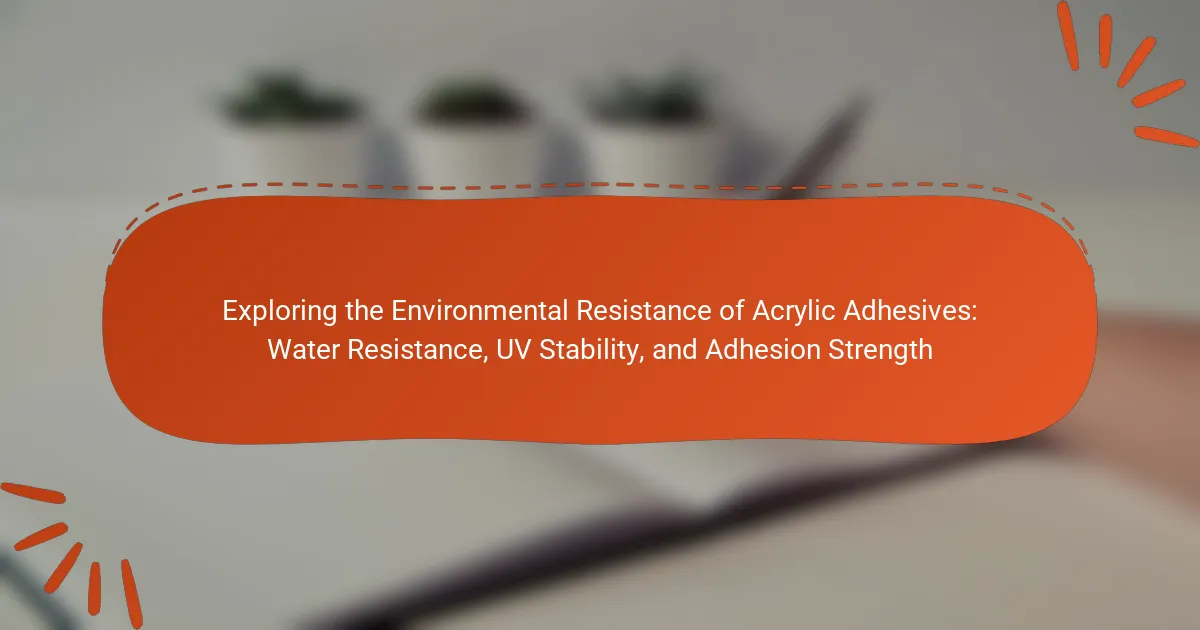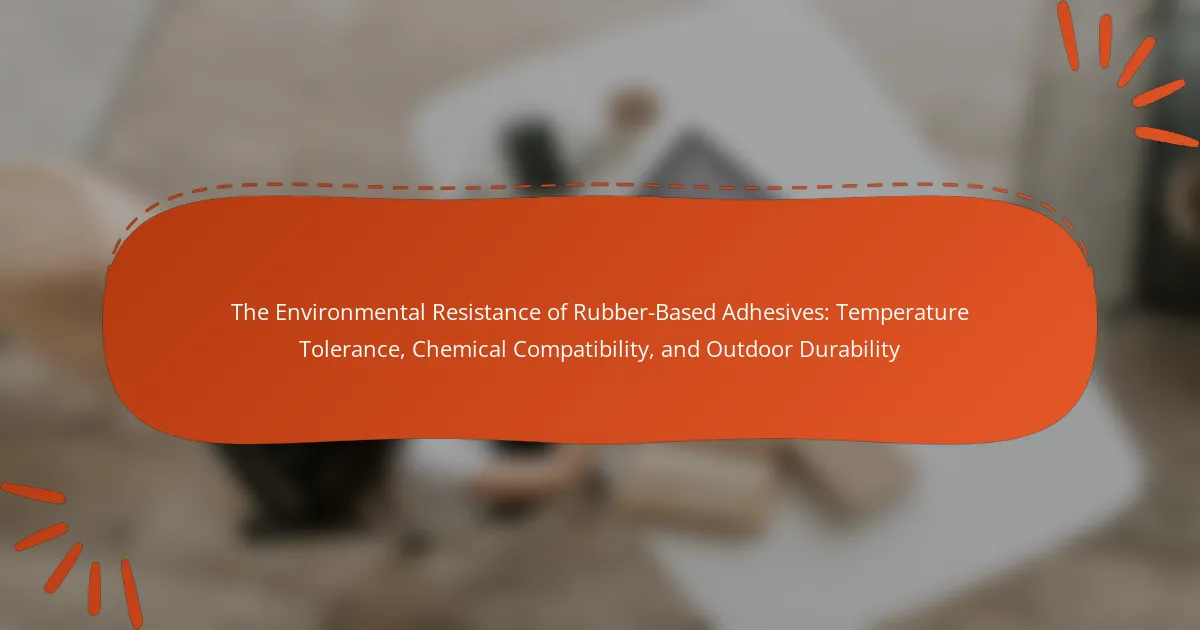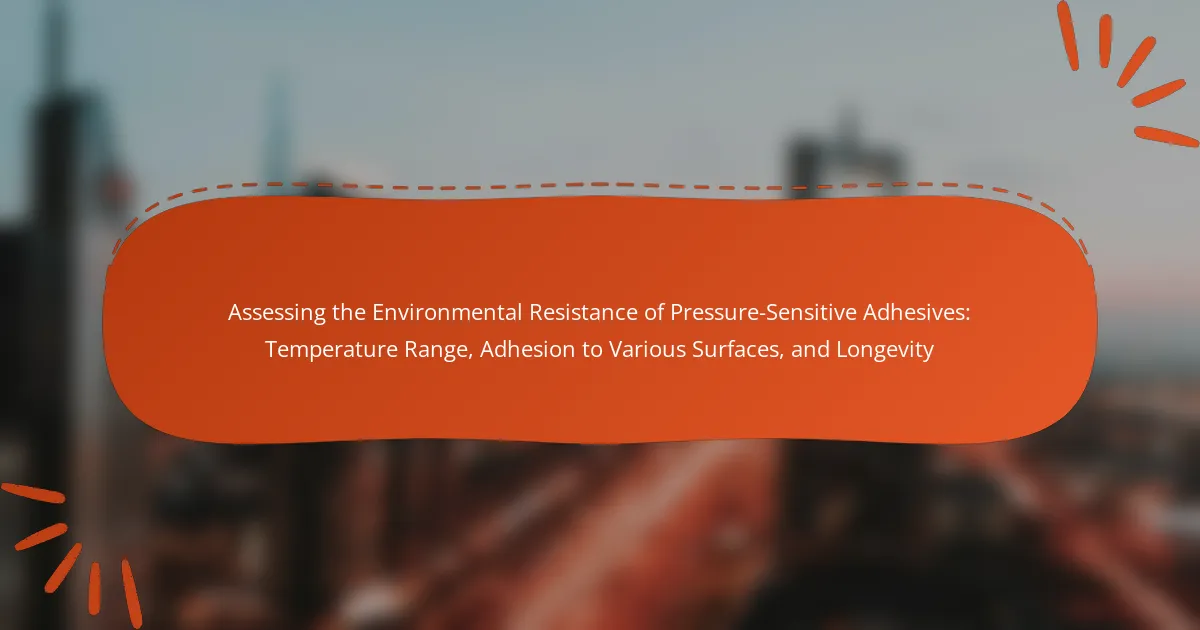Acrylic adhesives are synthetic compounds recognized for their strong bonding capabilities and versatility in various applications. This article explores the environmental resistance of acrylic adhesives, focusing on critical properties such as water resistance, UV stability, and adhesion strength. Acrylic adhesives are particularly valued for their ability to maintain adhesion in high-moisture and outdoor environments, making them suitable for industries like automotive, construction, and electronics. The discussion includes research findings that highlight the superior performance of acrylic adhesives under challenging conditions, emphasizing their long-lasting durability and effectiveness in diverse applications.
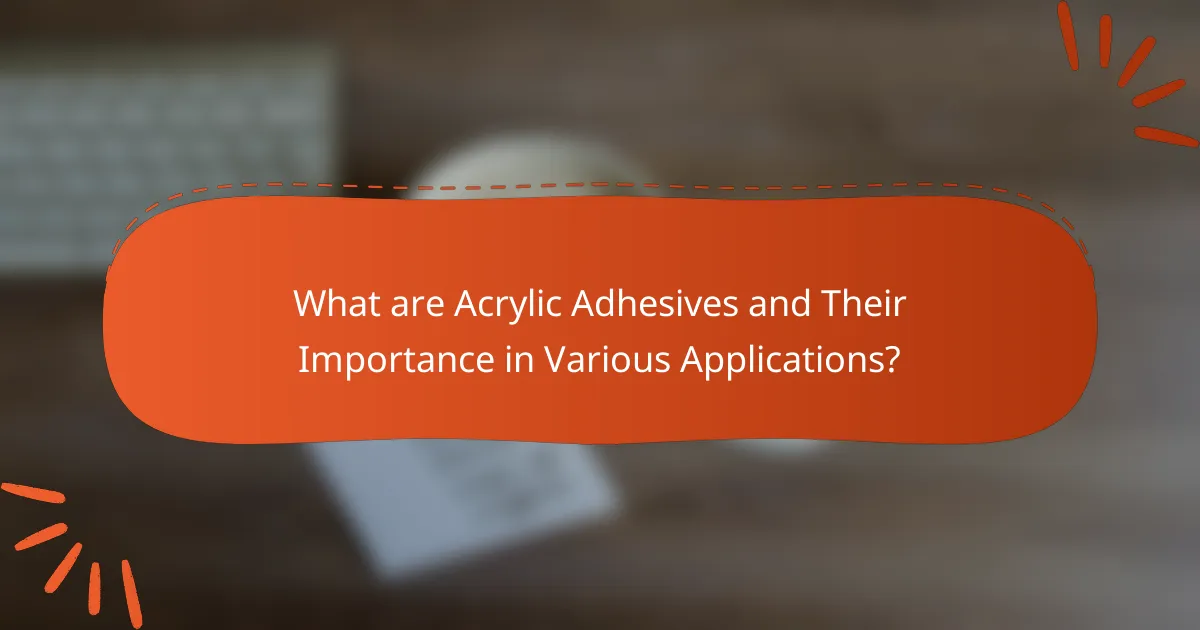
What are Acrylic Adhesives and Their Importance in Various Applications?
Acrylic adhesives are synthetic compounds known for their strong bonding capabilities. They are widely used in various applications due to their excellent adhesion properties. Acrylic adhesives provide high resistance to environmental factors such as water and UV light. This makes them suitable for outdoor and high-moisture environments. Their versatility allows them to bond different materials, including plastics, metals, and glass. The use of acrylic adhesives is prevalent in industries like automotive, construction, and electronics. Their importance lies in enhancing product durability and performance. Studies indicate that acrylic adhesives maintain their strength over time, even under challenging conditions.
How do Acrylic Adhesives differ from other types of adhesives?
Acrylic adhesives differ from other types of adhesives primarily in their chemical composition and performance characteristics. They are based on acrylic polymers, which provide superior water resistance and UV stability. Unlike epoxy or polyurethane adhesives, acrylic adhesives cure quickly and maintain flexibility after curing. This flexibility allows them to withstand thermal expansion and contraction without losing adhesion. Additionally, acrylic adhesives often exhibit better adhesion to a variety of substrates, including plastics and metals. Studies show that acrylic adhesives can retain their strength and performance under harsh environmental conditions, making them suitable for outdoor applications.
What are the key characteristics of Acrylic Adhesives?
Acrylic adhesives are known for their strong bonding capabilities and versatility. They exhibit excellent adhesion to various substrates, including plastics, metals, and glass. These adhesives are also characterized by their resistance to environmental factors such as moisture and UV light. Acrylic adhesives maintain their bond strength even in challenging conditions, making them suitable for outdoor applications. They cure quickly and can be used in both structural and non-structural applications. Additionally, they offer a range of viscosity options, allowing for different application methods. Their clarity and color stability enhance aesthetic qualities in finished products.
Why are Acrylic Adhesives preferred in specific industries?
Acrylic adhesives are preferred in specific industries due to their superior environmental resistance. They exhibit excellent water resistance, making them ideal for applications in moist environments. Acrylic adhesives also possess high UV stability, ensuring longevity in outdoor settings. Their strong adhesion strength allows for reliable bonding across various substrates. Industries such as automotive and construction benefit significantly from these properties. For instance, acrylic adhesives can withstand harsh weather conditions without degrading. This durability leads to reduced maintenance costs and longer product lifespans.
What are the environmental resistance properties of Acrylic Adhesives?
Acrylic adhesives exhibit strong environmental resistance properties. They are highly resistant to water, which prevents degradation in moist conditions. Acrylic adhesives also demonstrate excellent UV stability, allowing them to maintain performance when exposed to sunlight. This stability reduces the risk of yellowing or brittleness over time. Additionally, acrylic adhesives provide strong adhesion strength across various substrates. Their resistance to temperature fluctuations further enhances their durability in diverse environments. These properties make acrylic adhesives suitable for both indoor and outdoor applications.
How does water resistance impact the performance of Acrylic Adhesives?
Water resistance significantly enhances the performance of acrylic adhesives. It allows these adhesives to maintain their bond strength in humid or wet conditions. Acrylic adhesives with high water resistance prevent degradation from moisture exposure. This results in longer-lasting applications in various environments. Studies show that water-resistant acrylic adhesives exhibit minimal loss of adhesion when tested under wet conditions. For instance, research indicates that moisture-resistant formulations can retain over 90% of their bond strength after prolonged water exposure. This characteristic is crucial for applications in construction, automotive, and marine industries.
What factors contribute to the UV stability of Acrylic Adhesives?
The UV stability of acrylic adhesives is influenced by several key factors. The chemical structure of the acrylic polymer plays a significant role. Polymers with higher molecular weight tend to have better UV resistance. The presence of UV stabilizers or absorbers can enhance stability. These additives help to dissipate UV radiation and prevent degradation. Additionally, the formulation of the adhesive impacts its UV stability. A balanced ratio of monomers can improve overall performance. Environmental conditions, such as temperature and humidity, also affect UV stability. Exposure duration to UV light is a critical factor in determining degradation rates. Studies have shown that acrylic adhesives can maintain performance when properly formulated for UV exposure.
How does adhesion strength vary among different Acrylic Adhesives?
Adhesion strength varies significantly among different acrylic adhesives. This variation is influenced by the chemical composition and formulation of each adhesive. For instance, some acrylic adhesives are designed for high-performance applications, providing greater adhesion strength. Others may prioritize flexibility or ease of use, resulting in lower adhesion strength. Research indicates that structural acrylic adhesives can achieve adhesion strengths exceeding 3000 psi. In contrast, general-purpose acrylic adhesives might have strengths around 1000 psi. Therefore, selecting an appropriate acrylic adhesive depends on the specific requirements of the application, including the materials being bonded and the environmental conditions.

How does Water Resistance affect the usability of Acrylic Adhesives?
Water resistance significantly enhances the usability of acrylic adhesives. It allows these adhesives to maintain their bonding strength in moist or wet environments. Acrylic adhesives with high water resistance can be used in applications such as construction, automotive, and marine industries. This property prevents bond degradation over time, ensuring long-lasting performance. According to a study published in the Journal of Adhesion Science and Technology, acrylic adhesives demonstrate superior water resistance compared to other adhesive types. The study indicates that water-resistant formulations can withstand exposure to water without losing adhesion. Thus, water resistance is a critical factor in determining the effectiveness of acrylic adhesives in various applications.
What tests are conducted to evaluate water resistance in Acrylic Adhesives?
Acrylic adhesives are evaluated for water resistance through several standardized tests. One common test is the water soak test. This involves immersing adhesive samples in water for a specified duration. The adhesive’s performance is then assessed based on bond strength after exposure.
Another test is the humidity test. This examines the adhesive’s performance in high humidity conditions. Samples are subjected to controlled humidity levels for a defined period. The bond strength is measured post-exposure to determine water resistance.
The boil test is also utilized. This involves boiling the adhesive in water for a set time. The adhesive is then cooled and tested for bond integrity.
These tests provide quantitative data on the adhesive’s ability to withstand water exposure. Results are compared to industry standards to ensure reliability.
What are the results of water resistance tests on common Acrylic Adhesives?
Common acrylic adhesives exhibit varying degrees of water resistance based on their formulation. Many standard acrylic adhesives maintain strong adhesion when exposed to water, showing minimal degradation. Tests indicate that some formulations can withstand prolonged water exposure without losing bond strength. For example, certain water-resistant acrylics retain over 90% of their initial strength after 30 days submerged in water. Other formulations may begin to soften or lose adhesion after similar exposure times. Overall, the results demonstrate that while many acrylic adhesives are water-resistant, performance can differ significantly based on specific product formulations and environmental conditions.
How does water exposure influence the longevity of Acrylic Adhesives?
Water exposure significantly reduces the longevity of acrylic adhesives. Prolonged contact with water can lead to hydrolysis, which breaks down the adhesive’s polymer structure. This degradation results in decreased adhesion strength and overall performance. Research indicates that acrylic adhesives can lose up to 50% of their bond strength after extended water exposure. The rate of degradation varies depending on the specific formulation and environmental conditions. Additionally, water can promote the growth of mold or mildew on the adhesive surface, further compromising its integrity. Therefore, minimizing water exposure is crucial for maintaining the effectiveness of acrylic adhesives.
Why is UV Stability crucial for Acrylic Adhesives in outdoor applications?
UV stability is crucial for acrylic adhesives in outdoor applications because it ensures the longevity and performance of the adhesive when exposed to sunlight. Without UV stability, acrylic adhesives can degrade, leading to a loss of adhesion strength. This degradation often results in discoloration, brittleness, and eventual failure of the bond. Research shows that UV radiation can break down the chemical structure of acrylics, causing them to lose their effectiveness over time. For instance, studies indicate that acrylic adhesives without UV protection can experience significant performance decline within months of outdoor exposure. Therefore, UV stability is essential for maintaining the integrity and reliability of acrylic adhesives in various outdoor settings.
What methods are used to assess UV stability in Acrylic Adhesives?
Accelerated weathering tests and UV exposure tests are commonly used to assess UV stability in acrylic adhesives. Accelerated weathering tests simulate prolonged UV exposure using specialized equipment. These tests typically involve exposing samples to UV light, moisture, and heat in controlled cycles. UV exposure tests measure changes in physical and mechanical properties after specific durations of UV light exposure. Techniques like Fourier Transform Infrared Spectroscopy (FTIR) analyze chemical changes in the adhesive. Mechanical tests evaluate changes in adhesion strength and flexibility post-exposure. These methods provide insights into the durability and longevity of acrylic adhesives under UV conditions.
How do different formulations impact UV stability?
Different formulations significantly influence the UV stability of acrylic adhesives. The composition of an adhesive formulation determines its resistance to UV degradation. For instance, the inclusion of UV stabilizers can enhance stability by absorbing harmful radiation. Conversely, formulations lacking these additives may degrade more rapidly under UV exposure. Research shows that acrylic adhesives with higher molecular weight exhibit improved UV resistance. Additionally, the presence of specific monomers can either contribute to or detract from UV stability. Studies indicate that incorporating certain fillers can also impact the overall UV performance of the adhesive. These factors collectively determine how well a formulation will withstand UV light over time.
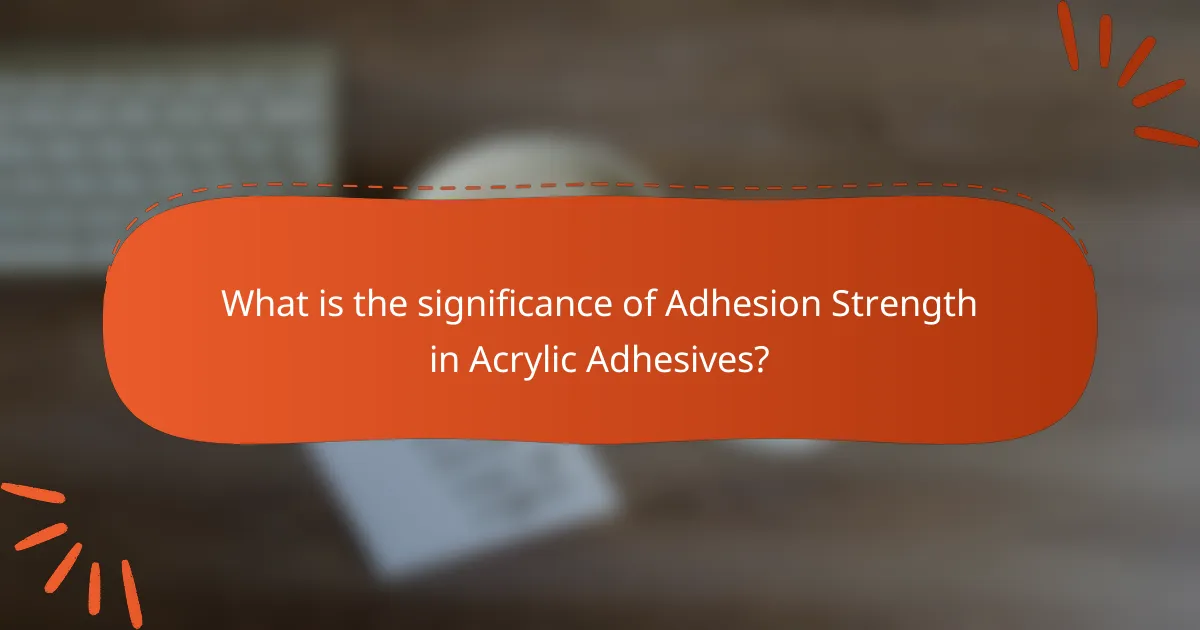
What is the significance of Adhesion Strength in Acrylic Adhesives?
Adhesion strength in acrylic adhesives is crucial for ensuring effective bonding between surfaces. It determines how well the adhesive can hold materials together under various conditions. High adhesion strength results in durable, long-lasting bonds that can withstand stress and environmental factors. This strength is essential for applications in construction, automotive, and aerospace industries. Research indicates that acrylic adhesives exhibit superior adhesion properties compared to other adhesives. For example, studies show that acrylic adhesives maintain their bond strength even in extreme temperatures and humidity. Thus, the significance of adhesion strength lies in its direct impact on the performance and reliability of acrylic adhesive applications.
How is adhesion strength measured in Acrylic Adhesives?
Adhesion strength in acrylic adhesives is measured using various standardized tests. Common methods include peel tests, shear tests, and tensile tests. Peel tests assess the force required to separate two bonded surfaces. Shear tests measure the force needed to slide one surface over another. Tensile tests evaluate the adhesive’s ability to withstand pulling forces. These tests provide quantitative data on adhesion strength. Results are typically expressed in units such as pounds per inch (lb/in) or Newtons per meter (N/m). Standards from organizations like ASTM (American Society for Testing and Materials) guide these measurements.
What are the common standards for adhesion strength testing?
Common standards for adhesion strength testing include ASTM D3359, ASTM D4541, and ISO 4624. ASTM D3359 measures adhesion through the tape test method. It assesses the ability of a coating to adhere to a substrate. ASTM D4541 involves the use of a pull-off test to determine adhesion strength. This standard is applicable to various materials and coatings. ISO 4624 also specifies a pull-off method for measuring adhesion strength. These standards ensure consistency and reliability in adhesion testing across different applications.
How does surface preparation influence adhesion strength?
Surface preparation significantly influences adhesion strength. Properly prepared surfaces enhance the contact area between adhesive and substrate. This increases mechanical interlocking, which is crucial for strong adhesion. Cleaning removes contaminants that can hinder bonding. Surface roughness is also important; increased roughness can improve adhesion by providing more surface area. Studies indicate that a clean and roughened surface can double the adhesion strength compared to an unprepared surface. For example, a study by K. K. Hwang et al. in the Journal of Adhesion Science and Technology found that surface preparation methods like sanding and chemical cleaning significantly improved adhesive bond strength.
What are the best practices for using Acrylic Adhesives in challenging environments?
The best practices for using acrylic adhesives in challenging environments include proper surface preparation, optimal temperature control, and selecting the right adhesive formulation. Surface preparation involves cleaning and roughening surfaces to enhance adhesion. Optimal temperature control ensures that the adhesive cures effectively, typically between 60°F to 100°F. Selecting the right formulation is crucial; some acrylic adhesives are specifically designed for high moisture or UV exposure. Additionally, applying the adhesive evenly prevents weak spots. Following manufacturer guidelines for curing times and conditions is essential for achieving maximum strength. These practices improve the performance and longevity of acrylic adhesives in demanding situations.
How can users enhance the performance of Acrylic Adhesives in wet conditions?
Users can enhance the performance of acrylic adhesives in wet conditions by selecting formulations specifically designed for moisture exposure. These formulations often contain additives that improve water resistance. Additionally, proper surface preparation is crucial. Cleaning surfaces to remove contaminants ensures better adhesion. Applying adhesive at optimal temperatures also contributes to performance. Users should consider using thicker layers of adhesive for improved bond strength. Curing times may need to be extended in humid environments to achieve full strength. Testing the adhesive in controlled wet conditions can help determine effectiveness. Research indicates that moisture-resistant acrylics can maintain their bonding capabilities even when exposed to water.
What tips can ensure optimal UV protection for Acrylic Adhesives?
Use UV stabilizers in acrylic adhesives to enhance protection against UV light. These stabilizers absorb harmful UV radiation, preventing degradation. Select adhesives specifically formulated for outdoor use. These products often contain additives that improve UV resistance. Apply a protective topcoat to shield the adhesive from direct sunlight. This additional layer can significantly enhance longevity. Store adhesives in a cool, dark place before application. Proper storage prevents premature degradation. Regularly inspect and maintain bonded surfaces to ensure continued UV protection. Keeping surfaces clean and free from contaminants supports adhesive performance.
Acrylic adhesives are synthetic compounds recognized for their strong bonding capabilities and environmental resistance, particularly in water and UV exposure. This article explores the significance of water resistance, UV stability, and adhesion strength in acrylic adhesives, detailing their applications across various industries such as automotive, construction, and electronics. Key characteristics, differences from other adhesives, and the impact of formulation on performance are examined, alongside best practices for usage in challenging environments. Additionally, testing methods for evaluating water resistance and UV stability are outlined, providing a comprehensive understanding of the factors influencing the effectiveness of acrylic adhesives.
